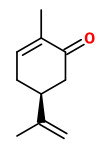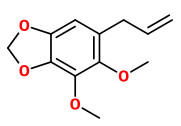Dies ist eine alte Version des Dokuments!
Anethum graveolens L. - Apiaceae - dill, garden dill, Dill, Gurkenkraut
Annual herb, 0.50-1.20m high, stem smooth, hollow, with white longitudinal stripes; leaves finely dissected, like those of fennel; umbels to 15 cm across, rays 30-40, spreading, subequal; flowers yellowish, the petals falling early; fruit 3-5 mm, half as wide, with dorsal ribs thin and sharp, lateral with distinct narrow wings; fl. time July-Sept.
With unknown origin, the herb has been cultivated since ancient times in Southwest Asia, the Mediterranean and Europe. Fresh leaves of dill are aromatic and are used to flavor foods such as fish, especially salmon, salads, pickles (e.g. cucumber), cheese, eggs, potatoes, tomatoes and soups (e.g. borscht). Dried leaves (known as dill weed) are also used as spice.
„Like caraway, the fernlike leaves of dill are aromatic and are used to flavor many foods such as gravlax… Dill seed, having a flavor similar to caraway but also resembling that of fresh or dried dill weed, is used as a spice. Dill oil is extracted from the leaves, stems and seeds of the plant.“
http://en.wikipedia.org/wiki/Dill
„Within the species Anethum graveolens three clans are distinguished, which are classified partly as varieties, some as sub-species:
Anethum graveolens L. var. hortorum Alef. - Gartendill (essential oil mainly carvone)
Anethum graveolens L. var. graveolens - Ackerdill
Anethum graveolens L. subsp. sowa bzw. f. sowa = Anethum sowa Roxb. ex Fleming - Indischer Dill (not as aromatic as var.hortorum, essential oil mainly dillapiole and carvone)“
http://de.wikipedia.org/wiki/Anethum_graveolens
Anethum graveolens herb
The amounts of aroma constituents of A.graveolens (whole herb, chopped, n-pentane/diethyl ether 1:2) varied widely depending on harvesting time. Five major aroma compounds comprised together 65-80% of the extract: α-phellandrene, β-phellandrene, limonene, p-cymene, and 3,6-dimethyl-2,3,3a,4,5,7a-hexahydrobenzofuran (dill ether).
[Composition and content of aroma compounds in dill, Anethum graveolens L., at three different growth stages., Huopalahti, R., Linko, R.R., Journal of Agricultural and Food Chemistry, Vol.31(2), 1983, 331-333]
Main aroma compounds of fresh dill were α-phellandrene (1980mg/kg), dill ether (398mg/kg), β-phellandrene (275mg/kg), and limonene (100mg/kg). Air-drying and freeze-drying led to severe losses of all aroma compounds, especially of α-phellandrene and dill ether. Aroma content of freeze-dried dill was lower than 10% than of fresh herb, but about four-fold that of dried dill.
„So freeze-drying is superior to air-drying in dill processing.“
[Huopalahti, R., & Kesälahti, E. (1985). Effect of Drying and Freeze-Drying on the Aroma of Dill—Anethum Graveolens CV Mammut. In Essential Oils and Aromatic Plants (pp. 179-184). Springer Netherlands.]
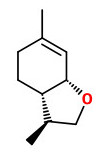 (3R,4S,8S)-3,9-epoxy-1-p-menthene dill ether |  (S)-α-phellandrene | 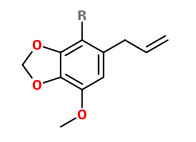 myristicin (R=H) |
„(3R,4S,8S)-3,9-Epoxy-1-p-menthene, methyl 2-methylbutanoate, (+)-(4S)-α-phellandrene and myristicin were the most important odorants of dill herb.“
[Evaluation of potent odorants in dill seed and dill herb (Anethum graveolens L.) by aroma extract dilution analysis., Blank, I., Grosch, W., Journal of food science, 56(1), 1991, 63-67]
„The dependence of the characteristic odour note of dill herb on the concentration levels of five compounds, having the highest odour units in an extract obtained from the fresh material, was studied. (S)-α-Phellandrene was evaluated as the character-impact compound of the dill flavour which was rounded off by an additive effect of (3R,4S,8S)-3,9-epoxy-1-menthene (dill ether). The contributions of myristicin, methyl 2-methylbutanoate and (R)-limonene to the dill flavour appeared less significant.“
[Sensory study on the character-impact flavour compounds of dill herb (Anethum graveolens L.). Imre Blank, Alina Sen, Werner Grosch, Food Chemistry, Volume 43, Issue 5, 1992, Pages 337-343] http://www.imreblank.ch/FC_1992_43_337.pdf
„While α-phellandrene, β-phellandrene, dill ether and carvone occur enantiomerically pure in all investigated plant parts and during all stages of maturity, both enantiomers of limonene are detected.“
[GC-IRMS and enantioselective analysis in biochemical studies in dill (Anethum graveolens L.)., Faber, B., Bangert, K., Mosandl, A., Flavour and fragrance journal, 12(5), 1997, 305-314]
Anethum graveolens fruits
Dried fruits (seeds) of Anethum graveolens: The umbels are cutted off shortly before full ripeness of the fruits and after drying the seeds are collected easily. [BI]
Description. Yellow-brown oval seeds, 3-5mm long and 2-4mm wide, with three pale brown dorsal ridges, the two lateral ones extended to form membranous wings. The drug ownes a strong characteristic aromatic odor and taste. [BHP83]
Constituents. Volatile oil (2.5-4%) with carvone (main component, 40-60%) and dihydrocarvone, limonene, α-phellandrene and β-phellandrene, trans-anethol, p-cymene, myrcene, α-pinene. Furthermore protein and fatty oil. [CRC, BI]
Effects. It was shown that carvone and limonene (also present in dill weed oil) induce the detoxifying enzyme glutathione S-transferase.
[Zheng GQ, Kenney PM, Lam LK, Planta Med, 58, (1992), 338-341]
On the other side the aqueous extracts of dill seeds exhibited a mutagenicity to Salmonella typhimurium bacterias.
[Fukuoka M, Yoshihira K, Natori S, et al., J Pharmacobiodyn, 3, (1980), 236-244]
The volatile oils from aerial parts and seeds of dill showed antimicrobial activity towards yeast Saccharomyces vini and lactic acid bacteria Lactobacterium buchneri.
[Shcherbanovsky LR, Kapelev IG, Prikl Biokhim Mikrobiol, 11, (1975), 476-477]
Uses. To promote appetite, as lactagogue, to treat dyspepsia, as stomachic, carminative, diuretic.
Dosage. As infusion, 1-2g chipped or crushed seeds per cup (150ml) water, thrice daily. [BI, BHP83] Essential oil: 0.1-0.3g as daily dose.
[Medicinal Plants of the World. Ben-Erik Van Wyk and Michael Wink, Pretoria 2004]
Among the volatile components of dill seed analyzed by gas chromatography-olfactometry, (+)-(4S)-carvone was the predominent odorant.
[Evaluation of potent odorants in dill seed and dill herb (Anethum graveolens L.) by aroma extract dilution analysis., Blank, I., Grosch, W., Journal of food science, 56(1), 1991, 63-67]
„(S)(+)-Carvone with high enantiomeric purity was detected in the seed and herb oils of caraway and dill.“
[Chiral GC analysis of (S)(+)‐and (R)(−)‐carvone with high enantiomeric purity in caraway, dill and spearmint oils., Ravid, U., Putievsky, E., Katzir, I., Weinstein, V., Ikan, R., Flavour and fragrance journal, 7(5), 1992, 289-292]
„GC-MS studies on essential oil resulted in the identification of 35 components, which account for the 98.9% of the total amount. The major component was carvone (55.2%) followed by limonene (16.6%), dill apiole (14.4%), and linalool (3.7%). The analysis of acetone extract showed the presence of 25 components, which account for 94.5% of the total amount. The major components were dill apiole (43.2%), linoleic acid (23.1%), trans-anethole (11.0%), 2-propanone 1-(4-methoxyphenyl) (4.6%), carvone (3.1%), p-anisaldehyde (2.7%), and myristicin (1.5%).“
[Singh, G., Maurya, S., de Lampasona, M.P. and Catalan, C. (2005), Chemical Constituents, Antimicrobial Investigations, and Antioxidative Potentials of Anethum graveolens L. Essential Oil and Acetone Extract: Part 52. Journal of Food Science, 70: M208–M215. ]
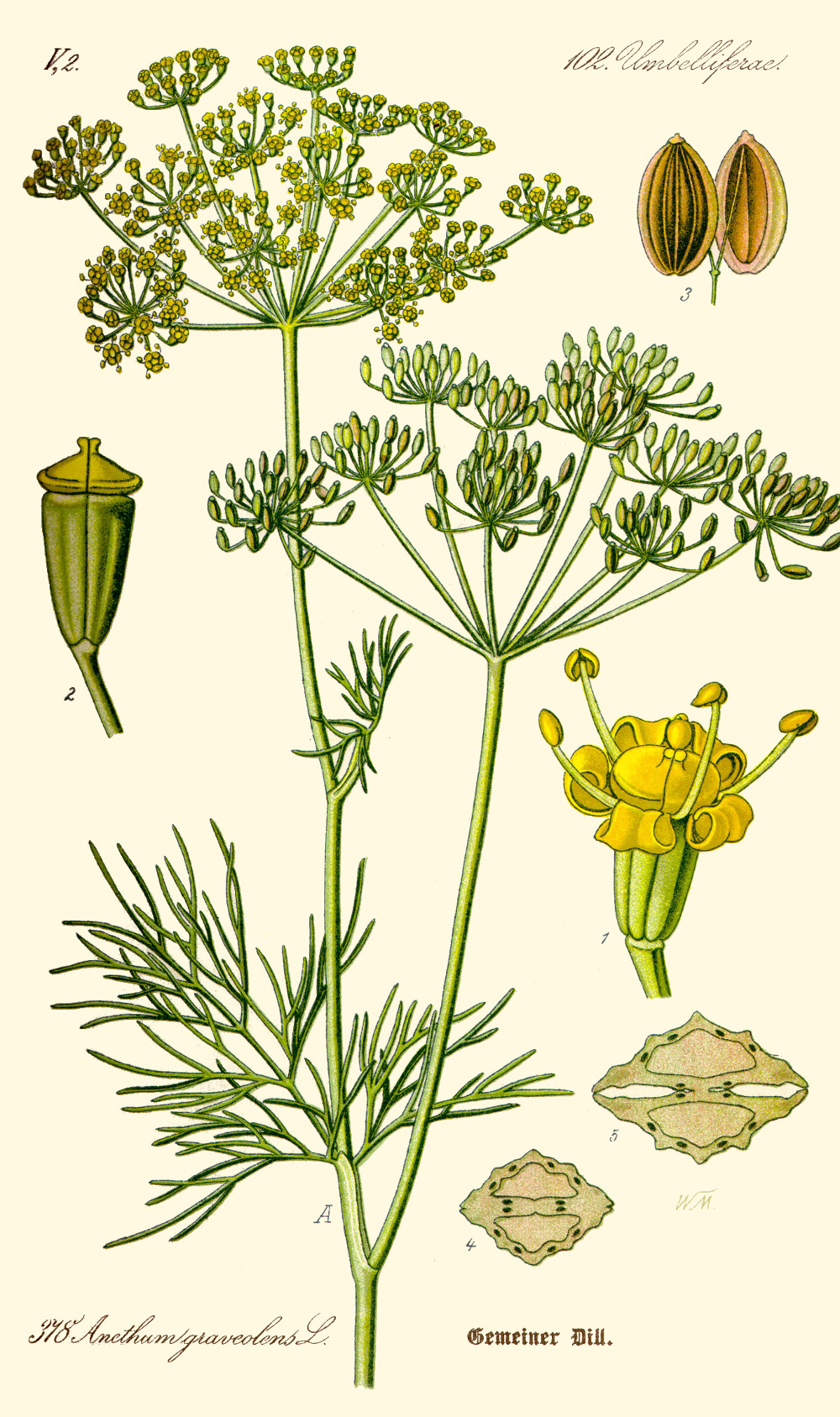
Thomé,O.W., Flora von Deutschland Österreich und der Schweiz, Tafeln, vol.3, t.378 (1885)
http://plantgenera.org/species.php?id_species=63277
Anethum graveolens
© Rolf Marschner (2010),
www.botanische-spaziergaenge.at

